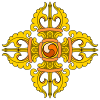|
The primordial Buddha Samantabhadra (Vajradhara, Dorje Chang, Kuntuzangpo in Tibetan) taught Dzogchen to Buddha Vajrasattva*, who transmitted it to the Indian Prahevajra (an emanation of Vajrasattva, Prahevajra is such a nirmanakaya, appearing as the first human lineage-holder of Dzogchen teachings) or Garab Dorje (55 CE).
Garab Dorje's birth is interpreted in the mystical land of Uddiyana, also the birthplace of Padmasambhava. Garab Dorje is said to have received all the Tantras, scriptures and oral instructions of Dzogchen directly from Vajrasattva (Diamond Being, Thunderbolt Being) and Vajrapani (one of the three protective deities surrounding the Gautama Buddha).
Garab Dorje transmitted the complete empowerments of Dzogchen to Manjushrimitra (an Indian Buddhist scholar, main student of Garab Dorje), who was regarded as his chief disciple. Padmasambhava is also known to have received the transmission of the Dzogchen tantras directly from Garab Dorje.
Garab Dorje summarized his teaching as follows:
The nature of mind is the original Buddha without birth or cessation, like the sky! When you understand that, all apparent phenomena are beyond birth and cessation. Meditating means letting this condition be as it is, without seeking!
As Garab Dorje attained paranirvana, his body dissolved into a rainbow light. Manjushrimitra called to his teacher — “What will become of us now that you are passing away? You are the light of the world…” and Garab Dorje responded by handing his last teaching, which was enclosed in a golden casket the size of a thumbnail he let fall into the hand of Manjushrimitra. As soon as he received it, his mind became the same as the wisdom mind of his guru Garab Dorje. Inside, the three precepts known as the "Striking the Vital Point in Three Statements" tsik sum nè dek (tshig gsum gnad brdeg) contain the whole of the Dzogchen teachings, and are a universal introduction to Dzogchen.
Garab Dorje's "The Three Statements that Strike the Vital Point" teaching, as translated by Lotsawa House:
Introducing directly the face of rigpa** itself — (ngo rang tok tu tré)
Deciding upon one thing and one thing only — (tak chik tok tu ché)
Confidence directly in the liberation of rising thoughts — (deng drol tok tu cha)
According to tradition, the Dzogchen teachings were brought to Tibet by Padmasambhava in the late 8th and early 9th centuries. He was aided by two Indian masters, Vimalamitra and Vairocana. They transmitted the Dzogchen teachings in three distinct series, namely the Mind Series (sem-de), Space Series (long-de), and Secret Instruction Series (men-ngak-de).
These teachings were concealed shortly afterward, during the 9th century, when the Tibetan empire disintegrated. From the 10th century forward, they were largely introduced as revelations of the concealed scriptures, known as terma.
The Dzogchen texts are influenced by earlier Mahayana sources such as the Lankāvatāra Sūtra and Indian Buddhist Tantras with their teaching of emptiness and luminosity, which in Dzogchen texts are presented as 'ever-purity' (ka-dag) and 'spontaneous presence' (lhun-grub).
The term Atiyoga (which refers to Dzgochen) first appeared in the 8th century, in an Indian tantra called Sarvabuddhasamāyoga. In this text, Anuyoga is the stage of yogic bliss, while Atiyoga is the stage of the realization of the "nature of reality." Atiyoga here is not a vehicle, but a stage or aspect of yogic practice. In Tibetan sources, until the 10th century Atiyoga is characterized as a "mode" (tshul) or a "view" (lta ba), which is to be applied within deity yoga.
The concept of rdzogs chen "great perfection", first appeared as the culmination of the meditative practice of deity yoga around the 8th century. The term dzogchen was likely taken from the Guhyagarbhatantra (Mahayoga teachings of the Secret Matrix Tradition) received by Garab Dorje from mahasiddha Kukuraja. This tantra describes how in the creation stage one generates a visualisation of a deity and its mandala. This is followed by the completion stage, in which one dissolves the deity and the mandala into oneself, merging oneself with the deity. Then follows a stage called rdzogs chen, in which one rests in the natural state of the innately luminous and pure mind. The Anuyoga and Atiyoga are still regarded as modes of Mahāyoga practice.
Nyingma
The Nyingma school's ancient origins of the Dzogchen teaching is attributed to 12 primordial masters that were Nirmanakaya buddhas that took forms in various realms. Each appeared to specific gatherings of beings and revealed certain teachings and doctrines. The 12th primordial master is said to be Buddha Shakyamuni.
Bon
According to Bon (considered to be the indigenous religious [shamanic] tradition of Tibet), Dzogchen originated with the Buddha Tonpa Shenrab Miwoche, who lived 18,000 years ago, ruling the kingdom of Tazik, which supposedly lay west of Tibet. He transmitted these teachings to the region of Zhang-zhung, the far western part of the Tibetan cultural world. |

